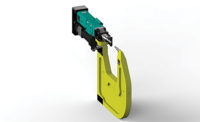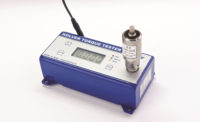Over the past 2 years, the price of steel has skyrocketed. In mid-2003, the price per ton of hot-rolled sheet steel was less than $300. By August 2004, hot-rolled sheet steel had reached a record price of $780 per ton. Although the price has retreated somewhat since then-it was $640 per ton in February-it's still far above the 10-year average price of $358 per ton. The story is similar with cold-rolled steel, galvanized steel and stainless steel.
If numbers like these have steel producers from Gary, IN, to Pittsburgh doing cartwheels, the same numbers are causing headaches for appliance assemblers throughout the country. Whirlpool Corp. (Benton Harbor, MI) is a good example. In the third quarter of 2004, the company's sales were up 6.6 percent compared with the same period in 2003, yet earnings were down 4 percent. In the fourth quarter, sales rose 8.1 percent, but earnings dropped 22 percent. Why? Whirlpool blames the rising costs of steel and transportation. Moreover, the appliance assembler expects its material costs to increase another 7 percent to 8 percent this year.
To overcome this challenge without dramatically raising the price of their finished goods, appliance assemblers are trying to economize on materials by using thinner sheet metal wherever possible. However, manufacturing engineers are discovering that the fasteners and tools that were effective on older, thicker parts don't always work well with thinner materials.
Fasteners for Thin Sheets
According to John Souza, applications engineering manager for Quality Screw & Nut Co. (Bensenville, IL), the best screw for fastening sheet metal depends on the thickness of the parts. He recommends trilobular thread-rolling screws for parts between 0.075 and 0.375 inch thick, and full-bodied thread-rolling screws, such as Pentaflow, Swageform and Square Flo, for parts between 0.04 and 0.07 inch thick.
"If you want to use a trilobular screw, such as Taptite, with parts between 0.025 and 0.06 inch thick, you have to punch and extrude the hole, because the screw needs 0.06 to 0.065 inch of thread engagement to work," says Souza.
If sheet metal parts require punched and extruded holes, assemblers should work closely with their fabrication house to ensure the quality of the parts. When the punch and die become worn, they can work-harden the material in and around the hole. This condition will not be apparent during fabrication, but on the assembly line, operators will suddenly discover that the thread-forming torque has become much higher, resulting in fastening problems.
"That happened to [a customer assembling dishwashers]," Souza remembers. "So we sent some screws and a torque tool to the sheet metal house. We told their guys to run screws in the parts periodically, and if the torque was over a certain limit, they would have to change the punch."
For parts less than 0.025 inch thick, thread stripping is a serious issue, because the seating torque is too close to thread-forming torque and the prevailing torque. "Unless you have a high-quality screwdriver that can control the torque to within 5 percent or better...standard sheet metal screws will not work. They will strip out, even if you punch and extrude the hole," warns Souza. "In thinner materials, the clutches on screwdrivers become very sensitive."
Quality Screw's High Torque Fastener System was designed to solve this problem. The system matches a special fastener with a buttress-type thread to a helix-shaped hole stamped into the base material. The thread captures the outside edge of the sheet in the helix. Because the thread matches the helix, the fasteners install like a machine screw, with no prevailing torque or thread-forming torque.
"It's like the old Acme thread," says Souza. "Instead of V-shaped threads, the threads are spaced out, and the root matches the width of the material to be fastened."
The helix is stamped into the base material during fabrication. This can be done in one or two steps, though the one-step operation will reduce the life of the tooling.
The helix moves the thread contact area outward approximately 0.09 inch, eliminating the problem of run-outs. The helix also acts like a conical lock washer. As the screw is tightened, the thread is compressed toward the center of the screw in a vise-like action. This puts the helix under load, which helps prevent loosening.
The system works in sheet metal from 0.011 to 0.105 inch thick and with thread sizes ranging from #2 to 5/8. The screws are sized according to the thickness of the base material.
Controlling Torque
When fastening sheet metal, selecting the right screw is only half the battle. The screw still needs to be installed with the correct torque, and a growing number of appliance assemblers are using DC electric power tools for the job. With their computerized controllers and graphic displays, DC electric tools can show engineers the relationship between torque and angle as the screw is tightened. Armed with that information, engineers can then devise the best fastening strategy for a joint, says Jeff Valder, marketing manager for Cooper Power Tools (Lexington, SC).
Valder recalls how DC electric tools helped a manufacturer of washers and dryers solve a problem. On one sheet metal application, pneumatic tools were stripping and cross-threading fasteners. "With a DC electric tool, we found there was a high prevailing torque at the start of the run-down, which was related to cutting those first few threads," he explains. "So, we used angle control for the first few fastener rotations. After that, the tool switches to torque control and angle monitoring. The company has saved so much money on warranty work that it is now repopulating all its plants with DC electric tools and controllers."
Valder remembers another success story involving a refrigerator manufacturer. The appliance's leg adjusters have to be installed to a certain depth. Without the angle control afforded by DC electric tools, there was no way to tell if the adjusters were installed at the correct height. DC electrics also helped the manufacturer solve a similar problem involving the door hinges.
"If the screws don't go in correctly, the door will be off-center," says Valder. "With the DC electric, we can program the tool so all the screws go down exactly level."
Clinching the Argument
Of course, another way to avoid problems with stripped screws is to do away with threaded fasteners altogether. Clinching methods, such as the Tog-L-Loc process from BTM Corp. (Marysville, MI) or the Tox process from Tox Pressotechnik LLC (Warrenville, IL), join sheet metal without screws, rivets or heat. Refrigerator manufacturers use clinching to assemble various sheet metal components, including the base, casing, doors and brackets. It's also used to assemble washers, dryers, dishwashers, furnaces, boilers, breadmakers, microwave ovens and other appliances.
"The biggest payback from the Tog-L-Loc process is with coated or galvanized steel," says Steve Sawdon, BTM's president. "You don't want to burn that coating off with a weld, and you don't want to break it with a screw or rivet. Besides, fasteners are expensive. It's another component you have to buy."
The clinching process works like this: The two sheets are brought together over a small, round die. A press then pushes a punch onto the metals, drawing them into the die. As the punch pushes down, the metal flows against the bottom and sides of the die, locking the sheets together.
The process can join plain, coated and oily metals; similar and dissimilar metals; and metals of different thicknesses. Both sheets together should be no more than 6 millimeters thick, and the process works best with a total sheet thickness of 1 to 4 millimeters. If the sheets are different thicknesses, the thicker sheet should be pushed into the thinner one.
The press can be a portable, handheld unit or a large, standalone machine. The power source can be hydraulic, pneumatic, hydropneumatic or electric, as long as it creates enough force to flow the metal and create the interlock. Pressing force varies with the size, thickness and composition of the metals. For a joint 4.6 millimeters in diameter, the pressing force is approximately 2.6 to 3 tons.
The punch and die are usually standard components and have a useful life of more than 250,000 joints. Punches range in size from 1.5 to 7.6 millimeters in diameter for the Tog-L-Loc system, and 3 to 12 millimeters in diameter for the Tox system.
Joint strength depends on the size of the punch and the thickness of the materials. A 3-millimeter punch used on two steel sheets 0.3 millimeter thick will produce a joint with a peel strength of 10 pounds and a shear strength of 60 pounds. A 6.4-millimeter punch used on two steel sheets 3 millimeters thick will produce a joint with a peel strength of 400 pounds and a shear strength of 1,210 pounds.
Joints range from simple overlap and flange designs to an overlapping corner joint or a round tube to a flat sheet. Ideally, the flange should be 10 millimeters wide.
The number of joints needed for an assembly varies. "It depends on the strength requirement for the product," says Sawdon. "We can assemble sample parts, and the customer can run all kinds of tests on them."


